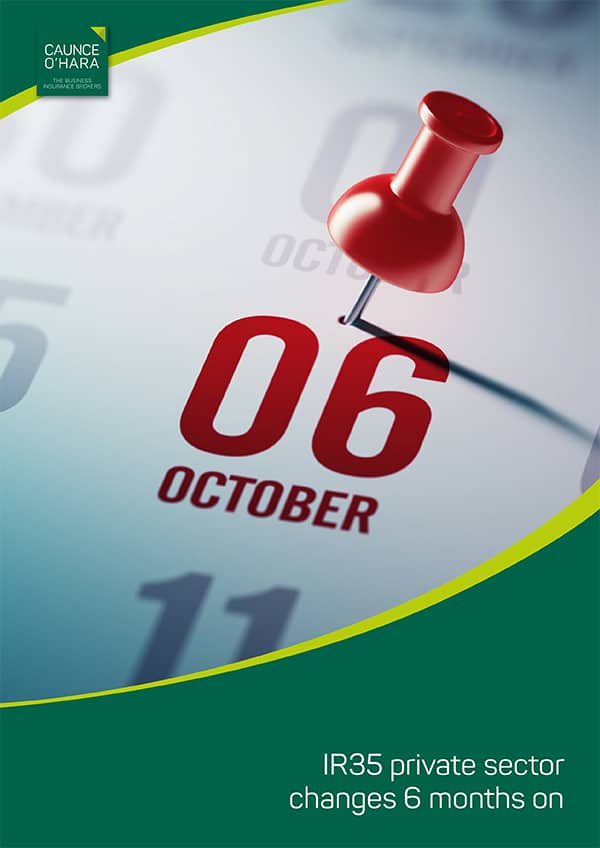Six months on from the introduction of IR35 to the private sector, we look at how IR35 impacts you as a self-employed contractor and reflect on the changes to the private sector off-payroll working rules.
Click the cover image to download our pdf IR35 guide.
If you prefer to read the text online, please continue reading the guide below…
In this guide, we will look at how IR35 impacts you as a self-employed professional and the things you need to think about moving forward. We will reflect on how the changes to the private sector off-payroll rules have affected the freelance and contractor landscape 6 months on.
The background of IR35
The key thing we want to get across to people here is that the underlying tax status issues haven’t changed.
Yes, legislation has been amended and there’s absolutely been a fundamental shift in who has to decide which engagements are inside and outside of IR35, certainly in the vast majority of cases.
Despite this, how we decide IR35 hasn’t changed. It all goes back to a 1968 judgement called “Ready Mixed Concrete”, which determined what makes an employee.
An employee is somebody that has to provide their personal service, who has to turn up, it is somebody who is controlled by someone else within their organisation; and also where ‘mutuality of obligations’ exists; i.e. simplistically put: there is a requirement for work to be offered and to be accepted.
If somebody is an independent contractor, they need to be able to demonstrate that at least one of those three points (mutuality of obligation, personal service and control) doesn’t exist.
However, mutuality of obligations, being the most vague of the three, is the most difficult to argue. You are therefore on much safer ground if you can demonstrate that there is no personal service, i.e. that you can send a substitute; and/or that you’re not being controlled and that it’s you specifically who determines how the work is done.
Demonstrate a lack of personal service or control, preferably both, then you are an independent contractor working outside of IR35.
If the matter cannot be decided on those three points (mutuality of obligation, personal service and control) you then look at the secondary factors which include the demonstration of financial risk (things like invoicing, the fact that engagements can end prematurely) but also wrapped up into that are in business factors such as using the services of an accountant, buying insurances, marketing your business and all of these are factors that need to be considered by whoever is making the IR35 decision.
Therefore, the basis of the decision making really hasn’t changed.
Amendments to IR35 legislation
For the first 21 years of IR35, the individual contractor was responsible for determining the status of their engagement in the private sector (but only until April 2017 in the public sector) and the contractor had the liability for it, which is why many thousands of contractors have had IR35 investigations over the last 21 years.
From 6 April 2021, if you’re engaged by a medium or large sized business, then it is the end client that has to make the IR35 decision. They have to determine IR35 using all of the factors discussed on page 3.
They do this under something called “chapter 10, a new element to IR35”. We now have this concept of the ‘fee payer’ and the fee payer is simply the entity that actually pays the contractor’s company. If you take a typical scenario of end client, recruitment agency and contractor’s company, then because the recruitment agency is paying your company, they are the fee payer.
If your company is engaged directly by the end client, then not only is the end client the decision maker, but they are also the fee payer.
Sole traders
One point to be made here is that not all freelancers trade through limited companies. There are many freelancers out there that operate as sole traders. If your business trades as ‘John Smith’ rather than ‘John Smith Ltd’, then you are a sole trader, and these changes do not affect your status nor do they affect the way you’ve been engaged.
It’s purely people who are contracting through limited companies who are affected by this year’s IR35 changes.
Filling a role vs ‘contracted out’ services
So, who actually makes the IR35 status decision?
The first thing to understand is really whether the end client is filling a role.
For example, is the end client saying they need a project manager, a business analyst and two engineers?
Or is the end client approaching a third party to say: “This is the particular project that needs to be undertaken, these are the milestones, the timescales and this is the project price. Can you supply the service?”
If the latter, then this is an outsourced service for which the third party will have the responsibility and will determine how it is resourced.
It could be a building project, outsourcing IT, contracting-out the canteen facilities or the cleaning. But to ‘pass on’ the end client responsibility for determining the IR35 status to a third party, it must be a genuinely outsourced service.
As HMRC’s guidance states: “labelling a contract as a contracted out service or a ‘statement of work’ when in reality the contract contains a provision for labour will not prevent the off-payroll working rules from applying, and the reality of the arrangements should be considered.”
Small consultancies and statements of work
Moreover, matters can get more complicated when the third party is also a small company because of the small company exemption.
Some 1.5 million small companies are outside of the decision-making process if they meet two of the following criteria:
• Turnover of no more than £10.2 million
• Balance sheet total of no more than £5.1 million
• No more than 50 employees (does not include
contractors)
These small companies are exempt from the decision making. This means for any contractor engaged by a small company; nothing has changed – you still have the responsibility and the liability for IR35 under the “old” (chapter 8) rules.
In terms of the small consultancies, there are many of these springing up with some taking on what they perceived to be projects and creating statements of work.
You have to be very careful that it is a genuinely outsourced service, as HMRC will likely be on the lookout for this as a potential source of avoidance – see HMRC’s guidance on contracted-out services: https://www.gov.uk/hmrc-internal-manuals/employment-status-manual/esm10010 – and these issues must be considered as we now explain a little bit more about the actual decision-making process.
Overseas clients
One other thing to be aware of is if you are engaged by an overseas client with no UK presence, then again, the chapter 8 rules apply.
You will have to make the decision on your IR35 status and you will also have the liability if it is incorrect.
The decision-making process
In the employment status manual, ESM10013 and ESM10014 concern the Status Determination Statement (SDS).
A medium or large-sized end client must make a decision. They have to communicate it properly; and they have to take reasonable care. It’s really important that they do this. ESM10013 clarifies the content of an SDS which must reference the contractual terms and the working practices. It should also consider any relevant in-business factors to consider everything in the round.
If you’re engaged directly by an end client, then it must be sent to you as the individual worker. If it’s through an agency, it’s got to be passed down to the agency and also passed on to you.
Every end client must have a client-led disagreement process because you have a right to challenge the SDS.
You’re probably only going to challenge an SDS if it determines that the engagement is inside and you disagree. You have the right to make a written challenge and the client must respond within 45 calendar days.
If the end client doesn’t respond or indeed meet its other statutory responsibilities outlined above, HMRC will saddle the fee-payer liability upon the end client, so it’s really important that end clients take their responsibilities seriously.
Transfer of debt
End clients may feel that having done what is required of them, they’re off the hook; but this isn’t necessarily the case.
The legislation includes ‘transfer of debt’ provisions such that if an entity below the end client fails because it cannot meet its tax liabilities, these can then be passed up the contractual chain.
We are already seeing businesses that are inserting themselves into the chain (at the point of payment intermediary on the diagram).
They are taking on the role of fee payer and HMRC’s concern is that if the fee payer ceases to exist when the tax needs to be paid, the tax receipts will be lost.
Arguably this measure has the added benefit of ‘keeping the contractual chain honest’, but it does mean that an end client, despite having gone about its responsibilities properly, really needs to be aware that the debt could come back up the chain and affect them at a later stage.
We will come on to potential protection against this later in this guide.
Are the end clients unprepared and sometimes evasive?
Many of you will be aware that this legislation was deferred for 12 months, after originally being planned for April 2020. (In fact, it was originally scheduled for April 2019).
When it was deferred in March 2020, there were a lot of end clients that had already made their decisions, particularly, but not exclusively in the finance and banking sectors. Many decided that they were no longer going to engage with contractors trading through limited companies.
This has been considered as end clients evading the IR35 issue and some people have challenged HMRC on these being blanket decisions. HMRC have responded to this by describing the choice not to engage with contractors trading through limited companies as a commercial decision for an end client to make.
That is correct, but by avoiding the engagement of limited company contractors, they may be putting themselves at a disadvantage.
For contractors, it means all the options are therefore Pay As You Earn which increases the tax burden for the contractor and lessens the appeal for the engagement. For end clients, it means the best talent – particularly those with transferrable skills – will look elsewhere for work. Why would an end client voluntarily forgo the best contractor resource?
However, there appears to be a mix of complacency and lack of awareness amongst end clients. The idea was never for end clients to start considering IR35 status on 6th April this year, the 6th April was the deadline by which end clients would have made those IR35 status decisions!
We wonder whether the complacency has arisen from HMRC’s well-advertised ‘light touch’ or ‘soft landing’ regime in the first 12 months. Whilst HMRC won’t be looking to charge a penalty (except for “deliberate non-compliance”), but if anyone thinks that HMRC won’t be looking to recover the additional tax and charge interest, they are very much mistaken!
Fee payers and ‘fee payer agencies’
The recruitment agency is the fee payer in the scenario where they sit in between the end client and contractor. So how prepared are they? Well, they can’t be fully prepared if their end clients haven’t told them what the position is.
There’s a question as to whether fee payer agencies can challenge the SDS. By law, they are likely unable to do so but commercially they may be able to say to an end client are you sure this is absolutely right and possibly even decide not to take on the engagement. You could argue that a recruitment agency as a fee payer actually is the final arbiter of status.
Recruitment agencies are clearly concerned about the fact that they are in the firing line. If the end client has met their legislative responsibilities, then potentially, the agency may end up with the fee payer liability and so some are looking for insurance solutions.
It is important to clarify the insurance position. It is the fee payer which has the liability and therefore the fee payer who should be buying the policy. It shouldn’t be pushed down on to the contractor, who has no liability in a chain with a medium or large-sized client.
As well as protecting the fee payer agency, a by-product of the insurance is protection of the end client from the transfer of debt. In the event that HMRC successfully challenges the engagement(s), the insurance will meet the tax bill, the agency will not fail because of a tax liability and so the end client is protected from any transfer of debt.
It should be clarified that tax loss insurance won’t protect the end client from having the fee payer liability transferred to them because of their failure to take reasonable care in the decision-making policy. It protects the chain below the end client, there will be no debt transfer concerns.
How have PSCs been affected?
You’ve gone from being centre stage for 21 years to rarely being the decision-makers and often, at best, influencers. With Covid having created business uncertainty and therefore reduced opportunities adding to the conservative approach by many end clients, your bargaining power has been restricted.
Some contractors have managed to achieve increases in their day rates to compensate for the additional tax burden of an inside engagement, but they are in the minority.
Only when you’re engaged by small companies and overseas clients, do you have the liability and you also have the ability via a contract review and contractor-focused tax losses insurance to do everything possible to protect yourself.
However, once your company is engaged by an end client who is a decision-maker, unfortunately you lose the 5% notional expense deduction available under Chapter 8 (old IR35).
This means every penny you earn is accounted for. It is either a tax deduction or your net take home pay. If your company is not making a profit, then any company expenses will effectively be paid from your own pocket.
As a consequence, many contractors don’t see the point often in continuing on inside engagements through their company particularly if they will last for the entire tax year. Many prefer working through an umbrella company or taking on some form of employed role.
Contractors do now have an appeal process in both the public and private sectors, but it feels like a plan to placate the contractor, and one doesn’t hear of appeals being accepted and inside IR35 decisions being overturned.
Already engagements are being advertised as inside or outside IR35, so rather than appeal the SDS, surely contractors will simply not apply for a role advertised as inside?
Warranty clauses in contracts
The other elephant in the room is the warranty clauses in contracts where end clients and agencies are trying to pass their fee payer liability on to the contractor, a liability which you don’t have if the end client is the decision maker, and the agency is the fee payer.
It is important to understand that if these warranty clauses are enforced, then despite the amount equating to the fee payer’s liability as assessed by HMRC. This will be a contractual liability when transferred from your end client/agency to you as the contractor.
It won’t be a tax liability and so unlikely to be covered by any insurance policy.
Our advice to contractors is to request that these clauses are removed. However, we appreciate that it may be the case that you have to accept the clause in order to be given the engagement.
Will HMRC consider your previous status?
For many contractors, there is the worry that HMRC enquire retrospectively and argue that your engagement which has now been deemed to be inside IR35 must have been previously (assuming your engagement began before 6th April and continued after the off payroll working rules were changed).
HMRC have made it clear on a number of occasions, including within their current guidance in ESM10036, that unless there is clear evidence of negligence, or even fraud, they will not be undertaking retrospective enquiries.
Has IR35 been a success for HMRC?
So far, it seems IR35 hasn’t worked very well for HMRC. We read about cases involving in particular high profile presenters, and there have been other less well publicised IR35 successes for HMRC, but looking outside of broadcasting and to your typical IT contractor or engineering contractor, arguing IR35 cases into individual contractors has largely proved to provide a poor return for HMRC’s considerable time and expense invested in these cases – hence the rule changes.
Furthermore, HMRC will need to police this new regime – and indeed from September 2021 have started to do so in the oil & gas sector – as they cannot allow complacency to seep into the market in the way it has in recent years.
We cannot see enquiries into individual contractors being something that we see a lot of in the future. HMRC’s focus will be elsewhere – reviewing whether end clients have fulfilled their statutory obligations.
What does the future of IR35 hold?
Unfortunately, many contractors have closed their companies down because of a lack of outside IR35 engagements and this may continue for some time yet. However, that isn’t just due to this legislation, there has also been the effect of COVID-19 which has dramatically restricted the number of freelance opportunities. Nevertheless, it does seem that opportunities are slowly starting to return as we see the economy pick up.
We can also draw on the experiences from 2014, when HMRC made legislative changes to tackle what they perceived to be false self-employment. For 12 months or so, nobody wanted to engage the self-employed, but eventually the market recognized that it was possible to engage with the new legislation and take on self-employed contractors by making sure the proper processes and procedures were in place.
Many contractors are now working through umbrella companies. As an umbrella worker, you are an employee and paying PAYE tax. This is a perfectly good way to work, as long as your umbrella company is not offering to pay you at lower rates of tax by, for example, a loan arrangement. If it looks too good to be true, then perhaps you should look elsewhere.
It is our opinion that over time, the market will likely rebound and those end clients which have opted not to engage personal service companies will suffer the consequences of not having access to the best freelance talent.
Over the next 6-12 months, we believe that common sense will start to prevail and the market will start turning back to normal, albeit one with a considerably lower limited company contractor population.
Conclusion
Will the contracting market go from perhaps 90% of contractors treating their engagements as outside pre-April 8th this year to 90% inside IR35 because of the concerns of end clients and agencies? No, it won’t. When people have a stronger understanding of IR35, they will engage with the legislation properly. More freelancers and contractors will return to being through limited companies. While it is an unsettled picture currently, we will get to some sense of normality in the next six to 12 months. It’s going to be a bit of a bumpy ride in the short term but these changes do NOT spell the end of freelancing!



